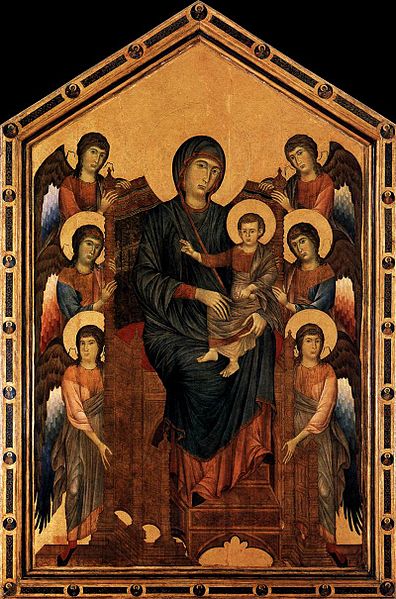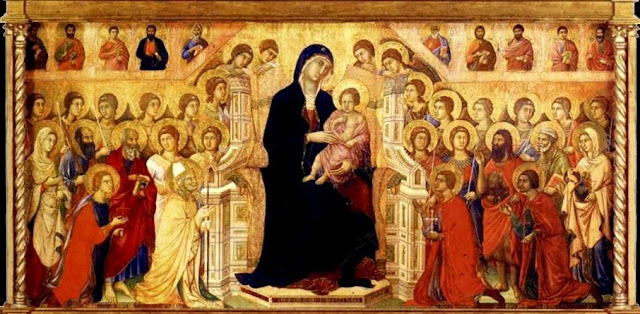The 16th century art historian Giorgio Vasari coined the terms Trecento, Quattrocento and Cinquecento to describe the 1300's, 1400's and 1500's.* I find myself using those terms as they refer to the time period rather than the style, calling this period the Trecento, though in the case of Cimabue, Duecento would be the more accurate term.
Virgin Enthroned with Angels, Cimabue, c-1290-95, Louvre
14' x 9' (4.27 m x 2.8 m)
Cimabue was the nickname of painter Cenni di Peppi and meant "ox-head" alternate accounts refer to either his stubbornness or homeliness. However, aside from that nickname Cimabue was well renowned and highly sought after as a painter. Born in Florence in 1240 he painted several monumental crucifix panels as well as church altarpieces with the Virgin and Child.
As the Louvre website states:
"Cimabue led the artistic movement in late 12th-century Tuscany that sought to renew the pictorial vocabulary and break with the rigidity of Byzantine art. The artist demonstrated a new sensibility, which endeavored to adhere more closely to reality."1
At first glance Cimabue's Madonna and angels do look rather stylized and abstracted, the faces are all similar and elongated, the angels hover weightlessly stacked on top of one another. However in comparison with Byzantine models his figures are more filled out and have realistic folds in their drapery. Their is an expressive and inquisitive look in each face of Cimabue's work. Byzantine icons are beautiful works of art, but were created for spiritual reasons and were never meant to reflect naturalism.
While Giorgio Vasari considered Cimabue to have started the Italian Renaissance, later art historian Frederick Hartt in his book History of Italian Renaissance Art: Painting, Sculpture, Architecture felt that Cimabue was instead the last artist of the Byzantine tradition.
The Ognissanti Madonna, Giotto, 1306-10, Uffizi
10.7" x 6.7" (3.25 m x 2.04 m)
The pictorial inventions of Giotto can be seen in his altarpiece created for the church of Ognissanti in Florence. Known as The Ognissanti Madonna (shown above), Giotto's figures have a solidity and weight to them. Faces are quite expressive and individualized rather than stylized, the throne is shown as a realistic three dimensional space and the angels are shown convincingly in front of one another rather than stacked on top of each other. Many art historians consider Giotto the father of the Italian Renaissance. His innovations in art are especially evident in his many fresco cycles where he clearly captures the emotions in each individual.
After his time stylized iconographic figures and altarpieces start to wane from Italian art.
Maestà (Virgin in Magesty), Duccio, 1308
Museo dell'Opera del Duomo, Siena
7' x 13.5' (2.13 m x 4.12 m)
Unlike Cimabue and Giotto who were Florentine, Duccio was a prominent painter from Siena. Sienese painting was similar to the art of the art of Florence even though the two cities had a bitter rivalry. Part of the rivalry was due to the political divide between the Guelphs who supported the Roman pope (Florence) and the Ghibellines who supported the Holy Roman Empire (Siena). Due to the ties with the Holy Roman Empire along with ties to the French papacy in Avignon, the Sienese had more artistic influenced which were derived from the International Gothic style found in Germany and France. This can be seen in the poses and folds of drapery in his figures. But Duccio like Giotto is painting in a way that captures the intelligence and personality of each saint and angel.
The front of the Maestà depicts the Madonna and Child enthroned with saints and angels (Maestà means the Virgin Mary in majesty), while on the reverse were nearly fifty scenes of the life of Christ.
As Keith Christiansen wrote in his article on Duccio and the Origins of Western Painting:
"Departing from the Byzantine notion of painting as a symbolic image of a divine being, Duccio, the founder of Sienese painting, endowed his figures with a new humanity, exploring the psychological relationship between Mother and Child."2
Cimabue, Giotto and Duccio are all in fact exploring the psychology of the figures they are painting and whatever one chooses to call this period in art, it is now evident that the ideas of Renaissance Humanism are taking hold in society.
*pronounced: "tray-chento," "kwatro-chento," and "cheen-quay-chento"
1 Louvre website- http://www.louvre.fr/en/oeuvre-notices/madonna-and-child-majesty-surrounded-angels
2 "Duccio di Buoninsegna: Madonna and Child (2004.442)". In Heilbrunn Timeline of Art History. New York: The Metropolitan Museum of Art, 2000–. http://www.metmuseum.org/toah/works-of-art/2004.442 (September 2010)





